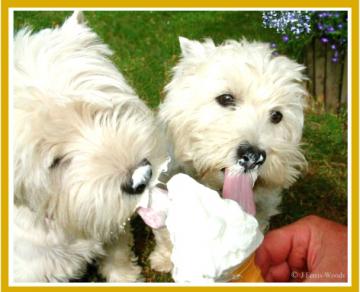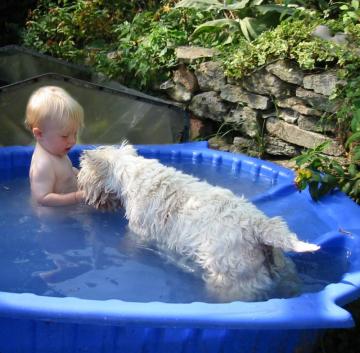Flaming June Has Arrived
17th of June, 2017 – Temperatures set to soar, and a testing time for our pets. See our tips to help them cope.


CARING FOR YOUR DOG IN HOT WEATHER
HEATSTROKE
A dog’s temperature is normally between 101.5F and 102.5F, and the average healthy dog’s body temperature is 101.5 ºF / 38.6 ºC. They regulate their body temperature by panting, which expels heat. If they cannot expel the heat fast enough their body temperature will rise and an increase of just 3 degreesF to 105 F can be very dangerous. At this temperature the dog is no longer able to cope with reducing his own body temperature and his oxygen demand is greatly increased.
When the body temperature reaches 108 F the major organs e.g. the heart, liver and kidneys will start to fail and even if the condition is treated rapidly the damage may be irreversible leading to long term serious health problems.
Heatstroke in dogs is often brought on by leaving them in a hot car (even with windows open) or exercising them during the heat of the day. Early signs of heatstroke can include rapid breathing, dry mouth & nose, excessive panting and excessive salivation, vomiting, diarrhoea, disorientation, wide eyes. If you notice any of these signs in your dog or if you notice another dog in a car, THIS IS AN EMERGENCY. If left untreated these symptoms will rapidly be followed by collapse, seizures, coma and death.
Heatstroke and sunstroke can damage internal organs and be fatal.
Emergency First Aid
Cool the pet down by opening all windows of the car in order to create a breeze or turn the air conditioning on. Pour cool water over the dog Offer sips of water to drink Rush the dog to the vet for further treatment Soak the dog in cool water. Freezing cold water will cause blood vessels to constrict so use cool water instead and wet your dog’s body all over making sure the water is soaking right through to the skin. Don’t frighten your dog by turning a hose on him, try to quickly soak him instead. Soaking the back of his neck will help to cool down the blood going to his brain,
Ways to avoid heatstroke
Never leave your dog in a car during warm or humid weather, even with the windows open. Avoid walking your dog during the daytime when the sun is at its hottest. Go for a walk early in the morning or late in the evening when the temperature is cooler.
Do not take your dog for long walks or let him over exert himself and stop regularly to rest and to offer him water to drink. Many dogs, particularly puppies get can get very excited and play regardless of the heat. It is your job to stop them for their own safety. Overweight and older dogs will suffer more in the heat, so be extra vigilant with them. Dogs with weakened heart and lung function will also need extra help to stay cool in hot weather. Make sure your dog has a shady place to get out of the sun at all times if it must be outside, and keep it indoors when it’s extremely hot. A tiled or concrete floor is a cooler place for your dog to lie. Do not let your dog stand around on hot tarmac pavements. Being close to the ground they feel the heat more readily, and the hot pavement will burn their pads. Keep your dog’s coat brushed and trimmed. However, it is a mistake to clip them close to the skin. You should leave the hair to a length of one inch to offer some protection against the sun. Like us, dogs can also suffer from sunburn. Westies and other white dogs are particularly prone to sunburn due to a lack of pigmentation in their skin. The tips of the ears, bridge of the nose, around the eyes and abdomen are areas which can become burnt easily due to the thin skin and not much hair covering in these sensitive areas. High factor waterproof sunscreen or complete sunblock can be applied, this will provide protection for vulnerable areas. You can now buy sunblock cream especially produced for dogs and pets, but prevention is a must and keeping in the shade is a priority.
Hot Weather and your dog’s temperament:
People can become irritable when they get too hot, and dogs are no different. Many dogs become more sensitive and less tolerant than usual, and it should be no surprise that more dog bites are incurred during hot or humid weather than in cooler weather. Ensure that children give the dog some peace and its own space.
Feeding
Give your dog 10% less food than normal and feed his meals at cooler times of the day e.g. early morning and evening.
Snake Bites
Once the weather starts to warm up, snakes will begin to come out of hibernation. The native Adder will have high concentrations of venom when it comes out of hibernation and a bite now can prove to be more dangerous than at any other point in the year. Adders only tend to bite if they are surprised, and a dog being curious will want to take a closer look. If you suspect that your dog has been bitten, you must get it to a Vet as soon as possible. There is no first aid treatment that you can give, all you can do is stay calm and try to minimise movement of the dog if possible, e.g. carry a dog to the car rather than allowing it to walk. Adder bites do not tend to be fatal but they can cause a lot of pain and tissue damage. Veterinary treatment often involves pain killers and rest.
